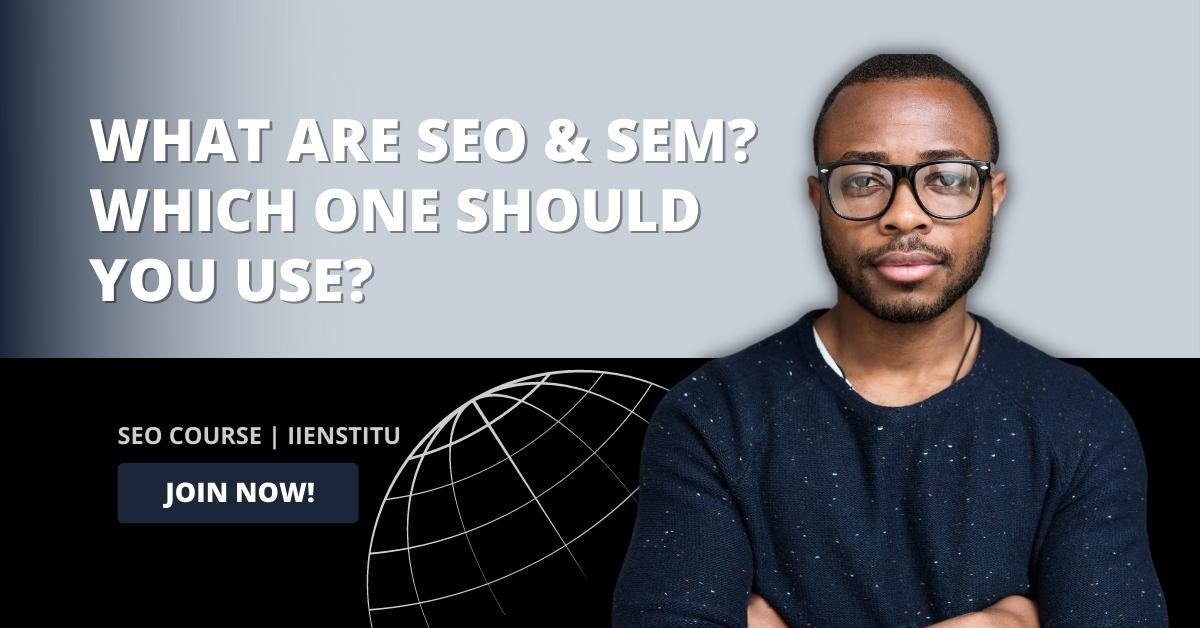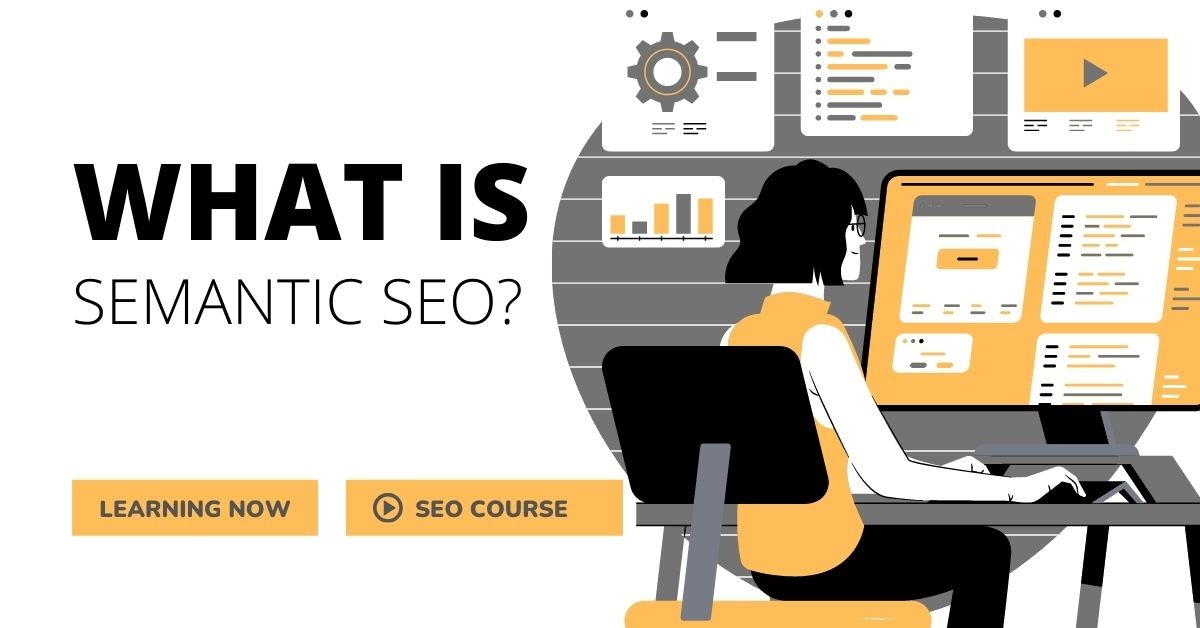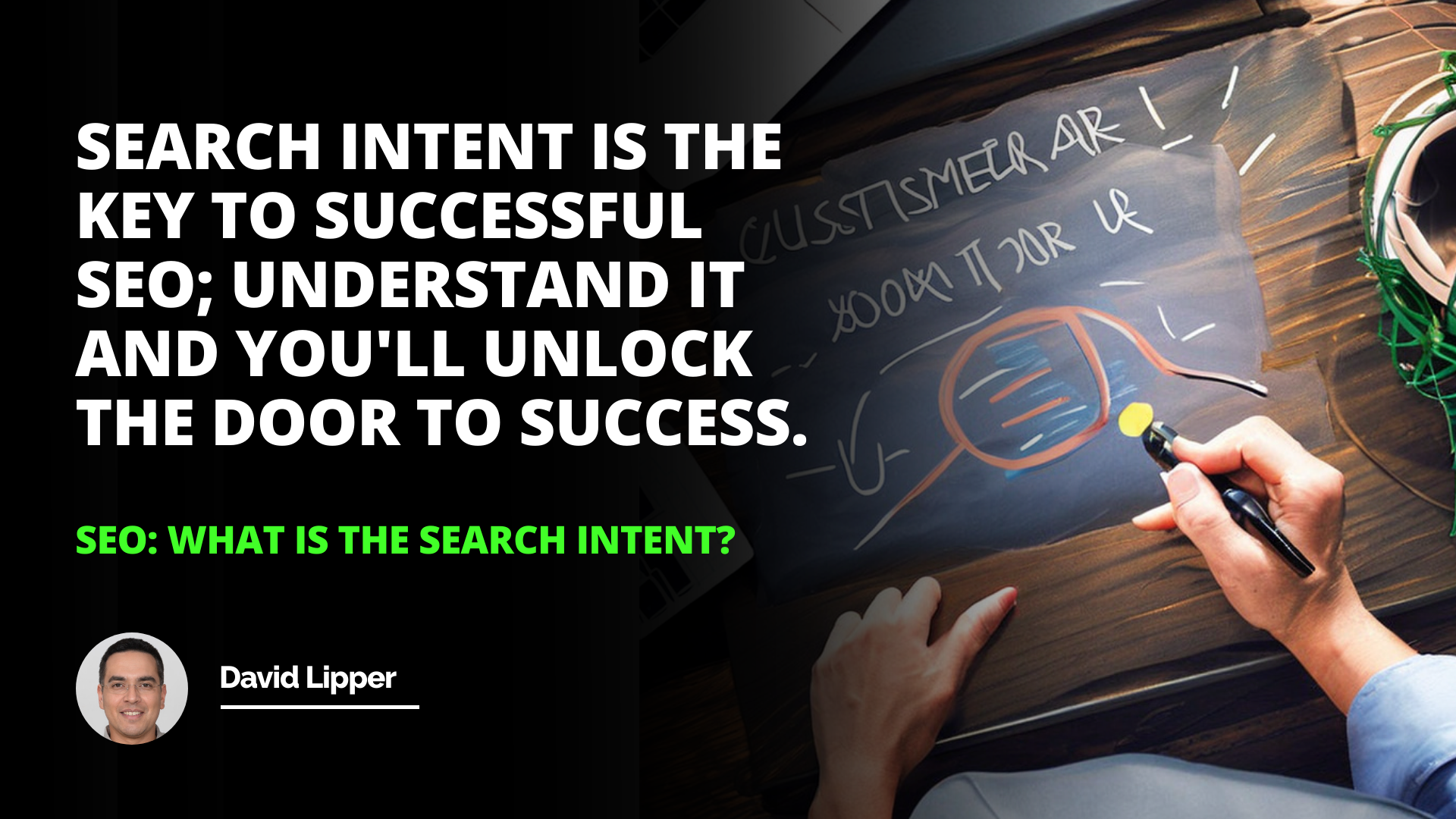
This article has explored the definition of search intent, the types of search intent, and the benefits of understanding search intent and concluded with a summary of key points.
Search intent is a concept that has become increasingly important in digital marketing, as it allows marketers to understand the motivations behind a user's search query and tailor content and experiences to meet their needs. There are three main types of search intent: transactional, navigational, and informational.
Related Course: Digital Marketing Course
The benefits of understanding search intent include creating content and experiences tailored to the user's needs and expectations and optimizing content and experiences for better search engine rankings. This article has explored the definition, types, and benefits of search intent.
Introduction
Definition of Search Intent
Types of Search Intent
Benefits of Understanding Search Intent
Conclusion
Introduction: Search intent is a concept that has become increasingly important in digital marketing. It is a way of understanding the motivations behind a user’s search query and using this information to tailor content and experiences to meet their needs. This article will explore the definition of search intent, the types of search intent, and the benefits of understanding search intent, and conclude with a summary of key points.
Definition of Search Intent
Search intent is the purpose behind a user’s search query. It is why a user is searching for a particular term or phrase and the expected outcome of the search. Understanding search intent is essential because it allows marketers to create content and experiences tailored to the user’s needs and expectations.
Types of Search Intent
There are three main types of search intent: transactional, navigational, and informational.
Transactional intent is when a user is actively seeking to initiate a conversion. This could include buying something, signing up for something, or taking another action.
Navigational intent is a user looking for a specific brand, product, or service. They search for a particular website, page, or another online resource.
Informational intent is when a user seeks general information on a topic or research in preparation for making an upcoming (but not immediate) buying decision.
Benefits of Understanding Search Intent
Understanding search intent is essential for digital marketers because it allows them to create content and experiences tailored to the user’s needs and expectations. By understanding the user’s intent, marketers can create content and experiences that are more likely to be successful in meeting the user’s needs. This can lead to increased conversions and better user experiences.
In addition, understanding search intent can also help marketers identify opportunities to optimize their content and experiences for better search engine rankings. By understanding the user’s intent, marketers can create content and experiences that are more likely to meet the user’s needs, leading to better rankings in search engine results pages (SERPs).
Conclusion: In conclusion, search intent is essential for digital marketers to understand. It is the purpose behind a user’s search query and the expected outcome of the search. There are three main types of search intent: transactional, navigational, and informational. Understanding search intent allows marketers to create content and experiences tailored to the user’s needs and expectations and optimize their content and experiences for better search engine rankings.
Search intent is the key to successful SEO; understand it, and you'll unlock the door to success.
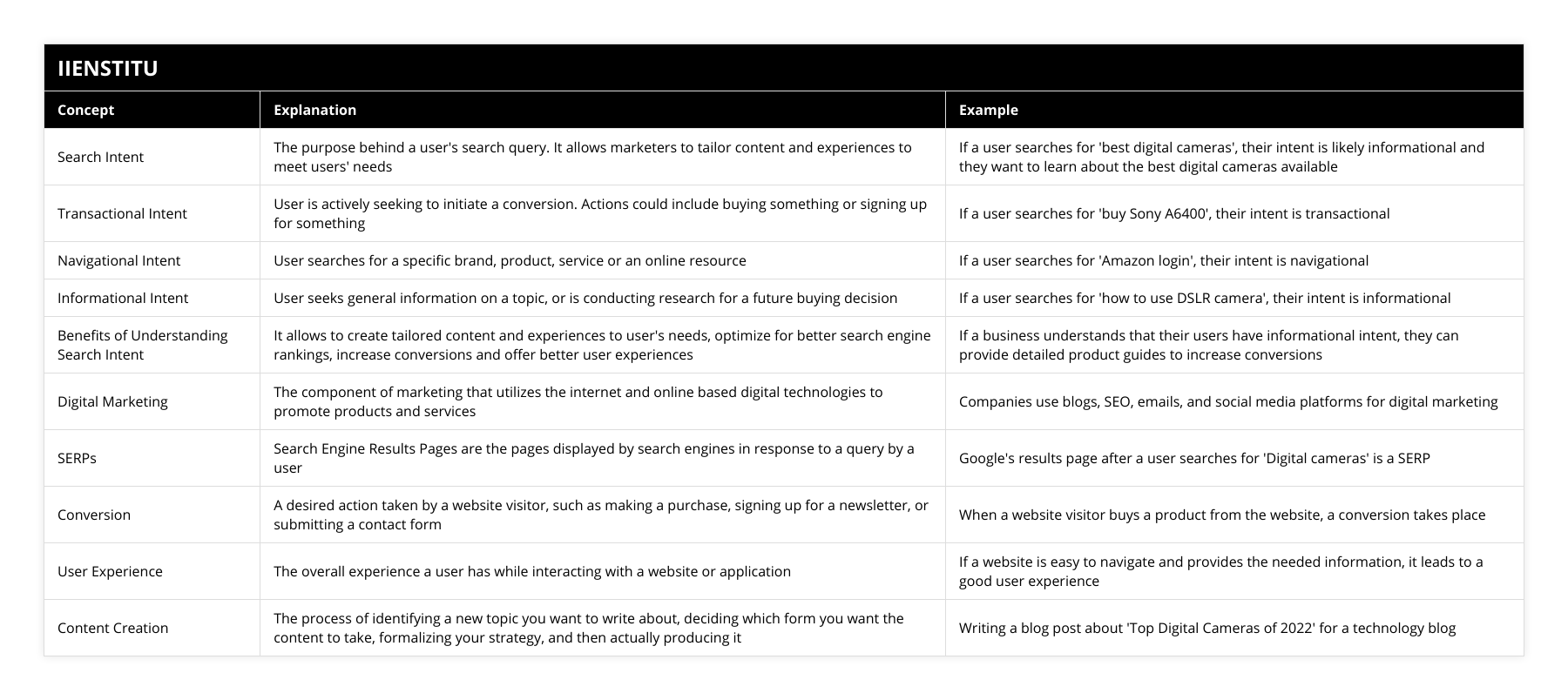
Frequently Asked Questions
What is the purpose of understanding search intent in SEO?
Search intent is an essential concept in SEO that refers to the purpose behind a user's search query. Understanding search intent is essential for optimizing a website so users can find it through the search engine. By understanding the purpose of the user's search query, SEO practitioners can tailor their website to meet the user's needs and ultimately drive more traffic to their website.
Search intent can be divided into three main types: navigational, informational, and transactional. Navigational search intent occurs when the user is looking for a specific website or page, such as a business or brand. Informational search intent occurs when the user seeks information about a particular topic. Transactional search intent occurs when the user wants to purchase a product or service.
By understanding the user's search intent, SEO practitioners can optimize their websites accordingly. For example, if the user is looking for a particular business, the SEO practitioner can optimize the website to appear in the top search results for that business. If the user is looking for information about a particular topic, the SEO practitioner can create content tailored to the user's needs and optimize accordingly. If the user wants to purchase a product or service, the SEO practitioner can optimize the website to appear in the top search results for the product or service.
In addition to optimizing the website for the user's search intent, understanding search intent can also help SEO practitioners to create more engaging content. By understanding the user's needs, the content created can be more relevant to the user, resulting in a higher engagement rate.
Overall, understanding search intent is an essential part of SEO. By understanding the user's needs, SEO practitioners can optimize their website to appear in the top search results and create more engaging content. Understanding search intent can lead to increased traffic, higher engagement rates, and improved website rankings.
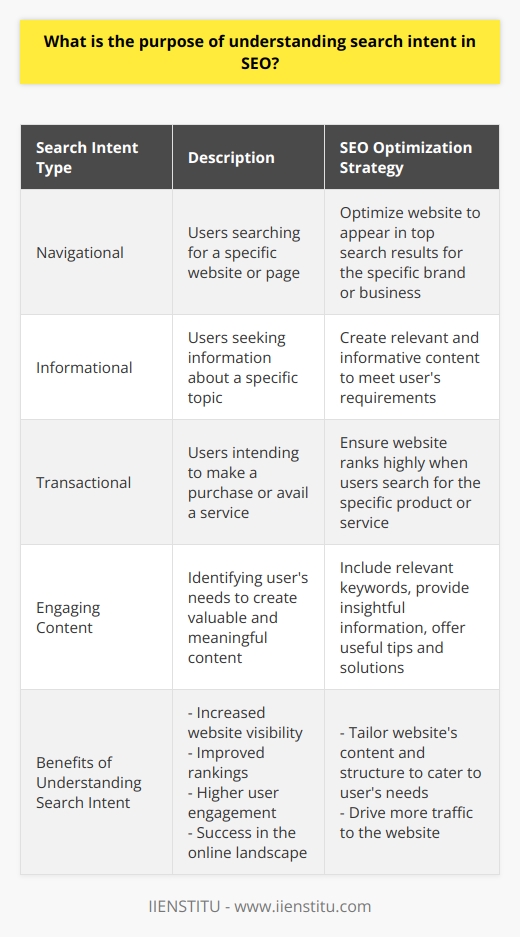
How can understanding search intent help improve SEO performance?
Search engine optimization (SEO) is optimizing web pages and content to increase visibility in search engine results. It is essential for businesses, as it can help increase organic traffic and improve website ranking. In addition, understanding search intent can be an effective tool to improve SEO performance.
Search intent is the context and purpose behind a query. It is the underlying reason why someone is searching online. People search for different types of information depending on the question. Understanding search intent can enable businesses to create more targeted and relevant content for their audience.
By understanding the intent of a query, businesses can create content that is more likely to appear in search engine results. For example, if a company has identified a question related to informational content, it can create content that answers it and provides helpful information. This content is more likely to appear in search engine results due to its relevance and accuracy.
Another way understanding search intent can improve SEO performance is through keyword research. By understanding the purpose of a query, businesses can identify keywords and phrases that are more likely to be used in the question. This can help optimize content for these keywords and phrases, resulting in higher rankings in search engine results.
Understanding search intent can also help businesses create content that is more likely to be shared. Knowing the purpose of a query can help companies to create content that is interesting and relevant to readers. This content is more likely to be shared and discussed, which can help improve visibility and website ranking.
In conclusion, understanding search intent can be an effective tool to improve SEO performance. It can enable businesses to create content that is more relevant and targeted to their audience, optimize content for keywords and phrases, and create content that is more likely to be shared. All of these strategies can help increase organic traffic and improve website ranking.
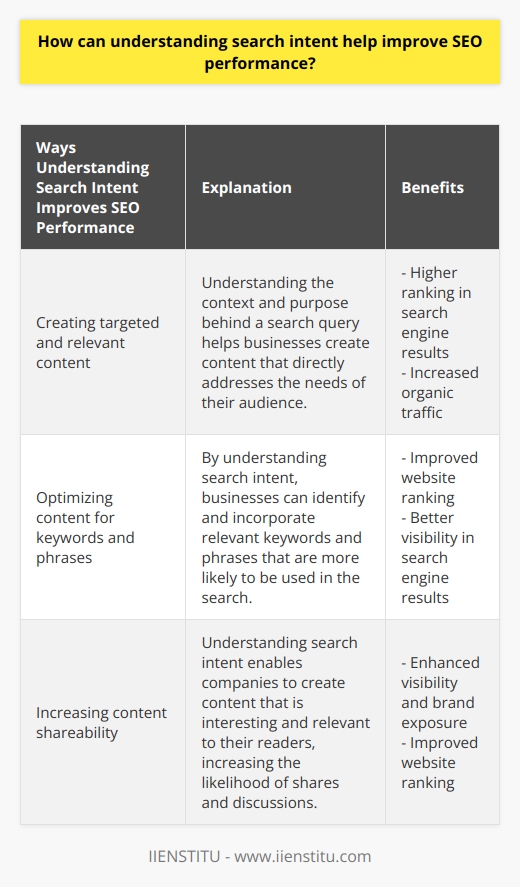
What are the different types of search intent?
When it comes to search engine optimization (SEO), search intent plays a crucial role in the success of a website. Search intent is essentially the purpose behind a person’s search query. Understanding it can help SEO practitioners create content most likely to appear at the top of search engine results pages (SERPs). This article will discuss the different types of search intent and how they can be used to optimize content for SEO.
In general, there are four main types of search intent: informational, navigational, transactional, and commercial. Informational search intent refers to the search query seeking educational information, such as “what is SEO?” or “how does SEO work?”. These queries are often used by people looking for more knowledge about a particular subject or topic.
Navigational search intent is when a person is looking for a specific website or page, such as “Facebook” or “Google homepage.” People looking for a particular service or product often use these searches.
Transactional search intent is when a person wants to purchase a product or service. These searches include “buy shoes online” or “best laptop deals.”
Finally, commercial search intent is when a person seeks information to make an informed buying decision. These searches include “best laptop reviews” or “which laptop should I buy?”.
Understanding search intent can help SEO practitioners create content tailored to the type of search query. For example, if a user is looking for “best laptop deals,” then the content should focus on providing information on the best laptop deals available. Similarly, if the user is looking for “which laptop should I buy?”, the content should provide detailed information about the pros and cons of different laptop models.
By understanding the different types of search intent, SEO practitioners can create content that is more likely to appear at the top of SERPs. This is because search engines are more likely to provide content tailored to the specific query. Furthermore, content tailored to search intent is more likely to be helpful to the user, resulting in higher engagement and more conversions. In other words, understanding search intent is essential for any successful SEO strategy.
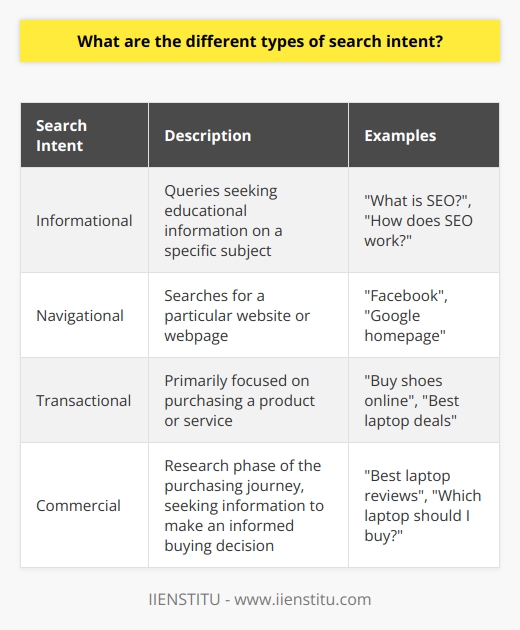
What is the relationship between search intent and the 3 C's in SEO?
Search Intent and the 3 C's
Understanding the Relationship
In the world of SEO (Search Engine Optimization), the relationship between search intent and the three C's - Content, Code and Credibility, is crucial. Search intent refers to the purpose behind a user's query entered into a search engine. Typically, search intent can be categorized into four main types: informational, navigational, transactional, and commercial investigation. The three C's, on the other hand, encompass the key elements that must be optimized to improve a website's visibility, rank well in search results and achieve digital marketing success.
Role of Content in Aligning with Search Intent
To begin with, Content plays a significant role in meeting the search intent of users. High-quality and valuable content that is rich in relevant keywords helps the search engines better understand the purpose of the webpage. This, in turn, ensures that the content is presented to users with matching search intent, enhancing user satisfaction and generating organic traffic.
Significance of Code Optimization
Next, Code optimization refers to improving the website's technical aspects to ensure search engines can efficiently crawl, index, and rank the website. Effective code optimization involves elements like meta tags, header tags, schema markup and site speed, which are instrumental in helping search engines interpret the search intent associated with a particular query. By optimizing your website's code, you improve its ability to cater to the intended audience and achieve better rankings in search engine results pages.
Credibility as a Determining Factor
Lastly, Credibility plays a vital role in connecting search intent to SEO outcomes. Online user trust is built on the credibility of the website, which is established through factors like domain authority, backlink profiles, and online reviews. A credible website is more likely to rank higher on search engine results pages, thus aligning itself with relevant search intent and attracting target users.
In conclusion, understanding the relationship between search intent and the three C's is fundamental to creating a successful SEO strategy. By optimizing content, code, and credibility, websites can effectively align themselves with the user's intents, thus increasing their chances of attracting organic traffic, improving user engagement, and achieving better search engine rankings.
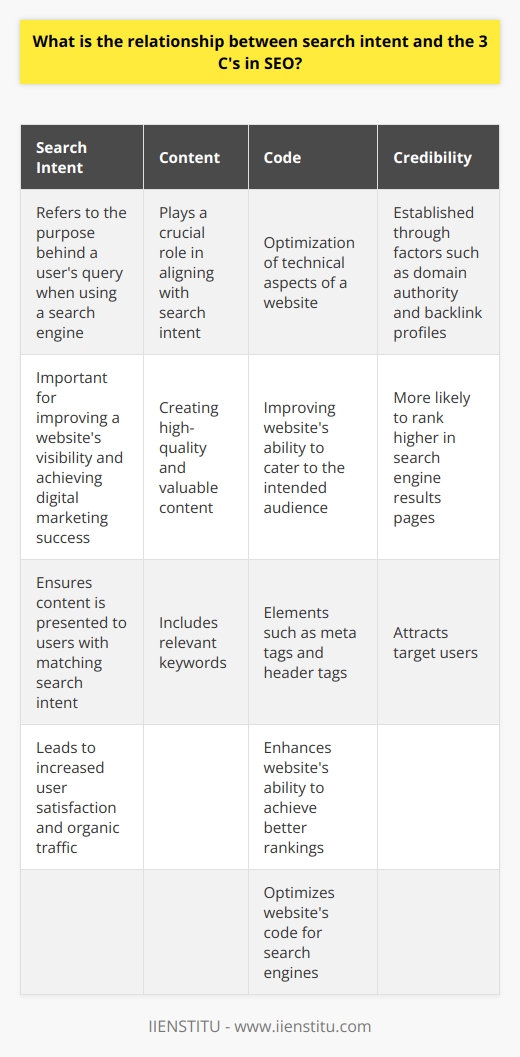
How can incorporating search intent into SEO strategy impact the overall user experience?
Understanding User Search Intent
Incorporating search intent into an SEO strategy can significantly impact the overall user experience, as it allows for a more targeted and relevant approach to content creation. By acknowledging and addressing the needs and expectations of users actively searching for information, websites and content creators can increase user satisfaction and engagement.
Fulfilling Specific Needs
Identifying search intent allows content producers to tailor their content to meet users' specific informational, navigational, transactional or commercial investigation needs. When a user's intent aligns with the content presented, they are more likely to find the answers, solutions, or steps they need, leading to a positive user experience.
Reducing Bounce Rates
Applying search intent-driven SEO can substantially reduce bounce rates by presenting content that directly addresses user queries. High bounce rates negatively affect the site's reputation in search engine rankings. A focus on search intent ensures that users stay longer on the site and engage more with the content, thus improving rankings and visibility.
Increased Trust and Authority
Addressing the needs of users through targeted content also increases the trust and authority of a website. When a site consistently provides relevant, valuable, and reliable information, users are more likely to return and recommend the site to others. Increased trust and authority directly impact the site's performance in search engine rankings and contribute to overall user experience enhancement.
Driving Conversions
Incorporating search intent into SEO strategy can transform website visitors into customers, crucial for the financial health of a business or organization. By targeting transactional or commercial investigation keyword phrases, content creators can guide users towards making a purchase, helping to achieve business goals in addition to delivering a positive user experience.
In conclusion, integrating search intent into an SEO strategy is vital for providing a positive overall user experience. It directly addresses user needs, reduces bounce rates, increases trust and authority, and drives conversions. By understanding user search intent, websites and content creators can ultimately improve their performance in search engine rankings while simultaneously satisfying users' needs and expectations.

What techniques can be employed to accurately analyze and categorize search intent for a specific target audience?
Identifying User Search Intent
To accurately analyze and categorize search intent for a specific target audience, several techniques can be employed. These methods aim to dissect the user's intent behind their search queries, providing insights into their needs and expectations.
Keyword Analysis
Firstly, keyword analysis should be conducted to identify common search terms and phrases popular among the target audience. This process includes evaluating search volume, keyword difficulty, and relevance to the subject matter. Furthermore, keywords can be segmented into four categories of user intent: informational, navigational, transactional, and commercial investigation.
Long-tail Keywords & Topic Clusters
Long-tail keywords exploration is another effective tactic to gain a deeper understanding of the user's search intent. These longer and more specific search queries offer valuable insights into the exact nature of the users' needs. To further analyze these long-tail keywords, topic clusters can be created by grouping related keywords and phrases to understand broader themes and patterns in user behavior.
User Behavior Metrics
Analyzing on-site user behavior metrics such as click-through rates, bounce rates, and time spent on the page contributes significantly to comprehending user intent. High click-through rates and low bounce rates indicate user satisfaction with the search results and their alignment with user intent.
Search Engine Algorithms
Leveraging search engine algorithms like Google's RankBrain or Hummingbird can help understand the context of the user's query better. These algorithms employ machine learning to decipher the semantic meaning behind search terms and distinguish search intent patterns for a specific target audience. Consequently, they enable the researcher to make informed decisions about content creation and optimization strategies tailored to address the different types of search intent.
Content Gap Analysis
Lastly, undertaking a content gap analysis will help identify potential search intent types or topics not covered by the existing content. By comparing the website or blog's content against competitor offerings or topic trends, the researcher can pinpoint areas of improvement and opportunities for targeting specific user intent.
In conclusion, utilizing various techniques such as keyword analysis, long-tail keyword exploration, user behavior metrics, search engine algorithms, and content gap analysis can significantly enhance the accuracy of search intent analysis and categorization. Armed with this knowledge, content creators can optimize their content to fulfill the needs and expectations of their target audience.
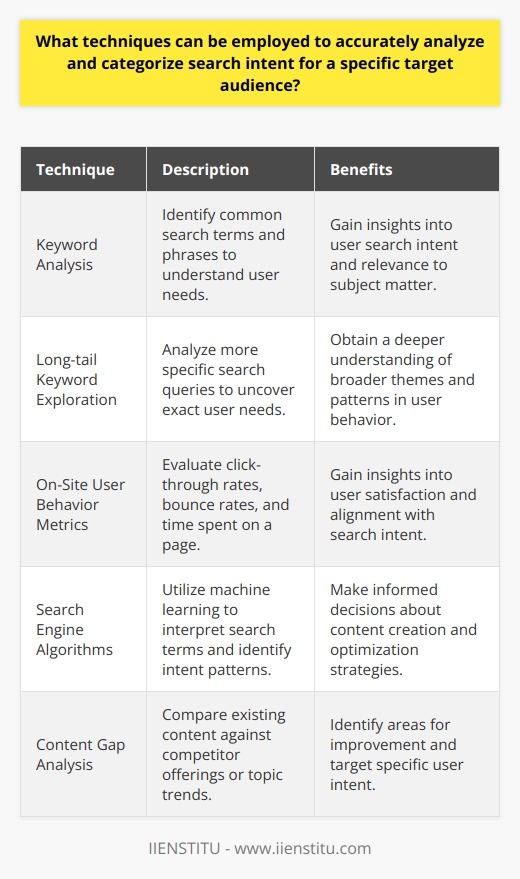
What is search intent and how does it affect SEO?
Understanding Search Intent
Search intent, often referred to as user intent, is the primary goal or motive a user has when entering a query into a search engine. It is crucial for the success of SEO (Search Engine Optimization) strategies, as understanding and catering to users' search intents can improve a website's visibility and ranking, leading to higher organic traffic and overall online presence.
Types of Search Intent
There are four main types of search intent: informational, navigational, transactional, and commercial investigation. Informational intent pertains to users seeking knowledge or answers to questions. Navigational intent involves users attempting to locate a specific website or resource. Transactional intent typically deals with users intending to make a purchase or complete a task, while commercial investigation reflects users who are researching products or services with possible intent to purchase later.
Relevance to SEO Strategies
SEO experts and content creators must consider search intent when developing their strategies for a more targeted and accurate approach. By optimizing website content to address users' search intents, practitioners can improve their website's relevancy and meet the search engine's criteria for quality content, ultimately resulting in better rankings.
Keyword Research and Search Intent
One practical way to understand and cater to search intent is through keyword research. Analyzing keywords used by users in their search queries can provide valuable insights into their intentions. Appropriate keyword targeting can significantly boost content effectiveness and align it with the needs and expectations of the target audience.
Content Creation and Optimization
Creating and optimizing content in line with users' search intent is key to achieving better engagement and search visibility. Producing high-quality, relevant content that directly addresses users' needs and queries contributes to a positive user experience, which, in turn, positively affects SEO performance.
In conclusion, understanding search intent is pivotal to formulating effective SEO strategies. By focusing on users' search intents, content creators and SEO practitioners can better meet the requirements of search engine algorithms, ultimately leading to improved website visibility and higher organic traffic.
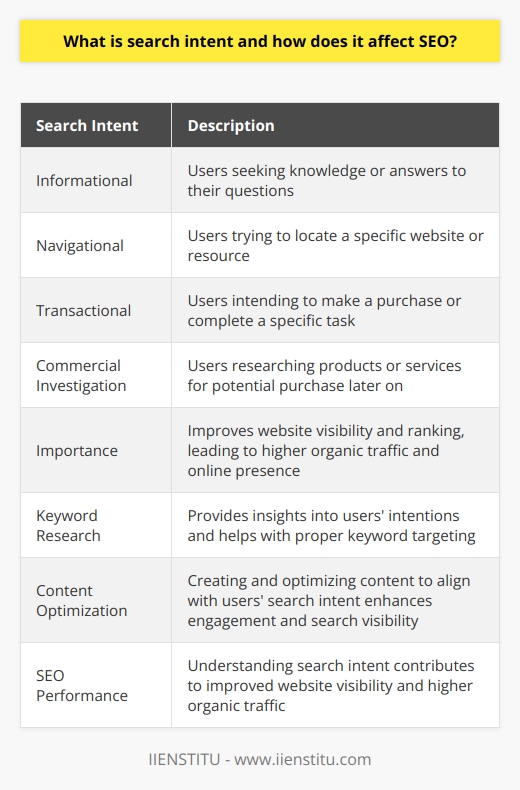
How do you identify search intent in SEO?
Understanding User Intent
One of the fundamental aspects of search engine optimization (SEO) involves identifying search intent. This process helps create content that aligns with users' needs and expectations, ultimately enhancing the website's online visibility and value.
The Four Classifications of Search Intent
To effectively recognize search intent, it is crucial to consider four primary classifications: informational, navigational, transactional, and commercial investigation. Differentiating among these categories can provide valuable insight into users' motivations when browsing the internet.
Informational Intent
Users searching for answers to specific questions or seeking general knowledge about a topic exhibit informational intent. By incorporating relevant keywords, facts, and data in the content, one can tailor the information to address these users' needs.
Navigational Intent
Navigational intent refers to queries aimed at locating a specific website or web page. Aligning the website's metadata and internal linking structure can optimize user experience and meet this type of intent.
Transactional Intent
Transactional intent involves users searching for products or services with the intention of making a purchase. To accommodate this intent, providing clear calls-to-action, showcasing product benefits, and maintaining accurate pricing information are key elements to consider.
Commercial Investigation Intent
Lastly, commercial investigation intent occurs when users seek recommendations, reviews or comparisons before making a purchase decision. Displaying testimonials, securing industry accreditations, and creating comparison guides can enhance engagement with these users.
Using Keyword Analysis
Analyzing keywords significantly contributes to the identification of search intent. Examining specific terms and search phrases can reveal patterns or themes, which can then inform content creation strategies.
Optimizing for Click-Through Rates (CTR)
Higher click-through rates indicate that the content aligns with search intent, generating more engagement. Optimizing metadata, particularly the title tag and meta description, can encourage increased CTR and indicate an effective match between the content and the user's intent.
Analyzing Engagement Metrics
Assessing engagement metrics, such as bounce rate, time on site, and pages per session, can further reveal search intent. High engagement signifies successful content optimization, while low engagement may suggest improvements are needed to better align with user intent.
In conclusion, identifying search intent is a crucial aspect of SEO to ensure that content is tailored to users' needs and preferences. By considering the four classifications, analyzing keywords, optimizing for CTR, and evaluating engagement metrics, SEO professionals can create content that resonates with their target audience and enhances the overall online experience.
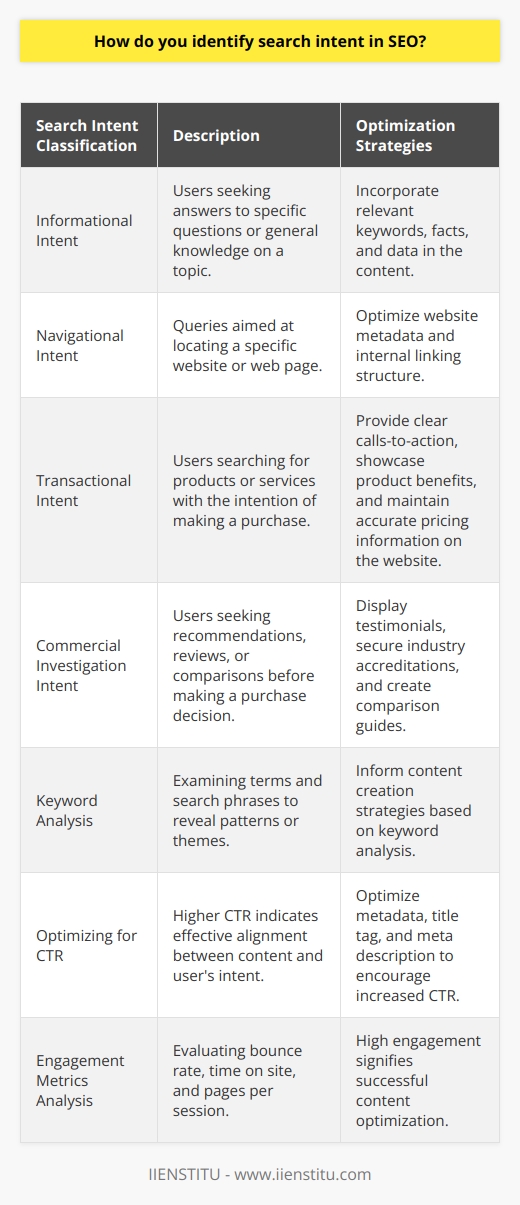
What are the 3 C's of search intent?
Analyzing the Three C's of Search Intent
Identification of Search Intent
The concept of search intent revolves around understanding why users type specific queries into search engines and predicting the end goal behind each action. Identifying search intent is crucial for optimizing a website's content and improving its search engine rankings, leading to better user experience and higher conversion rates. In order to analyze search intent effectively, it is essential to focus on the three C's: content, context, and clarity.
Content: Meeting User Needs
The first of the three C's, content, requires an assessment of the relevance and usefulness of a page's content in relation to the user's search query. Content should provide accurate, up-to-date, and comprehensive information, satisfying users’ needs and surpassing their expectations. To optimize content, utilizing target keywords, ensuring readability, and presenting information in a clear, concise manner are key factors.
Context: Understanding User Motivations
Context, the second factor, involves acknowledging the broader picture in which users search, including their background knowledge, prior experiences, and specific motivations. By recognizing these dynamics, content creators can tailor their content to speak directly to users' requirements and address their concerns effectively. This approach includes analyzing search patterns, user behavior, and demographics, as well as understanding trending topics and cultural references.
Clarity: Focusing on User Experience
The third C, clarity, emphasizes the importance of intuitive navigation, visual appeal, and seamless interactions when delivering content. A clear and user-friendly website design, combined with easily accessible, relevant content, can significantly enhance users' overall experience. Working on elements such as headings, page layout, and media usage also contribute to create a coherent message that corresponds to users' search intent.
In conclusion, by analyzing the three C's of search intent – content, context, and clarity – content creators and marketers can optimize their web presence and effectively cater to users' needs. By comprehensively addressing search queries and providing added value to users, websites can gain a competitive edge in search engine rankings and improve their overall performance.
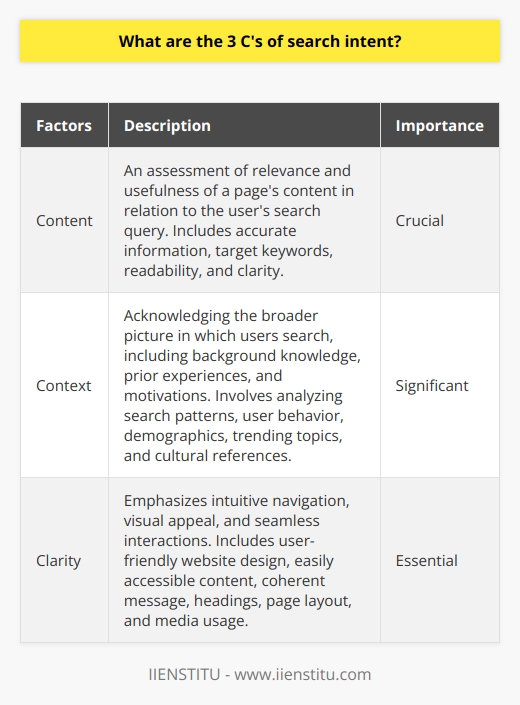
What is an example of a search intent?
### Search Intent Example
An example of search intent can be illustrated through the behavior of a user when accessing a search engine. When users input queries into a search engine, they tend to have a goal or objective that they wish to achieve with the information they receive. This objective or goal is their search intent.
### Informational Search Intent
One common type of search intent is informational intent. Under this intent, users seek knowledge or information on a specific topic or subject. They may look for answers to their questions or for data to support their decisions. For instance, if an individual enters the query 'how to take care of a cat,' their search intent is to learn the necessary steps and advice for tending to a cat.
### Navigational Search Intent
Another type of search intent is navigational intent. This occurs when users search for a specific website, brand, product, or service. They may already know what they want to find but need guidance navigating to the correct web page or site. An example of this intent is when a user types 'Amazon' into a search engine, indicating that they want to visit Amazon's website.
### Transactional Search Intent
Finally, transactional search intent is when a user searches with the intention of making a purchase or taking a certain action. These actions could be signing up for a newsletter, downloading an app, or purchasing an item online. For example, if a user searches for 'best smartphone deals,' their intention likely involves comparing smartphone prices and features before making a purchase.
Understanding and addressing the various types of search intent is crucial for content creators and website owners, allowing them to create content that accurately satisfies users' needs and expectations. By identifying the users' search intent, businesses can optimize their websites and marketing strategies to better serve their audience and achieve higher search rankings and conversion rates.
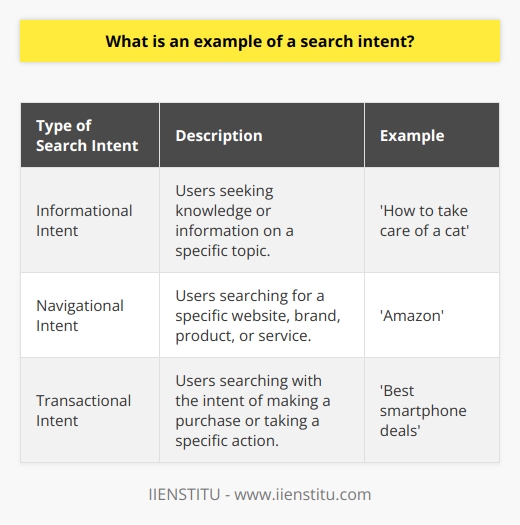
Why is search intent important for SEO?
Understanding User Needs
Search intent is instrumental in SEO because it provides insight into the specific information users are seeking. By understanding query intentions, content creators can tailor their content to better address users' demands, thus increasing the likelihood of ranking higher in search engine results.
Incorporating Relevant Keywords
Focusing on search intent allows companies to pinpoint relevant keywords and optimize content accordingly. By using phrases and terms that mirror the language of users, website owners can organically attract targeted traffic and enhance their online visibility.
Diversifying Content Formats
Another crucial aspect of search intent is the consideration of different content formats. Recognizing diverse intent types (informational, navigational, commercial, or transactional) guides the development of varied content forms, such as blogs, videos, and product pages, that cater to different audiences. This diversification ultimately contributes to a more comprehensive and engaging website experience.
Tailoring User Experience
A critical function of search intent in SEO is its ability to inform user experience (UX) design. By having an in-depth understanding of users' needs, website owners can modify their sites with relevant features and navigation systems that facilitate access to information, creating positive experiences and reinforcing user trust.
Measuring Content Performance
Search intent can also be leveraged to evaluate and refine content performance. By monitoring metrics like bounce rate and dwell time, website owners can identify areas in which their content is not effectively serving user needs, prompting improvements. This continuous analysis and modification enhance overall SEO performance.
Enhancing User Engagement
Lastly, focusing on search intent helps improve user engagement with content. By providing relevant and useful information, businesses are more likely to retain users' attention and establish long-lasting connections that encourage repeat visits and generate conversions.
In conclusion, search intent is a crucial component of SEO as it enables content creators to better understand and address users' needs, incorporate relevant keywords, diversify content formats, tailor user experiences, measure performance, and enhance engagement. By prioritizing search intent, businesses can significantly improve their online presence and achieve desirable ranking positions.

What are the 3 C's of search intent?
Understanding Search Intent: The 3 C's
The Concept of Search Intent
Search intent, a crucial aspect of search engine optimization (SEO), refers to the specific goal a user has in mind when performing a search query. Understanding search intent is vital for crafting effective content strategies and optimizing websites for better visibility and higher engagement. The three C's of search intent can help to better grasp this notion: content, context, and clarity.
Content: Meeting User Needs
The first C, content, is essential in addressing the searchers' requirements and providing valuable, relevant information in response to their query. Websites must deliver high-quality, unique, and informative content that aligns with user objectives, whether they aim to educate, solve a problem, or entertain. For instance, how-to articles cater to users looking for a solution, while opinion pieces target those seeking a thought-provoking perspective.
Context: Presenting Information Appropriately
The second C, context, refers to the presentation of content in a manner that appeals to the user's intent and satisfies their query. This aspect involves elements such as domain authority, multimedia usage, and website structure. Domain authority is crucial in instilling trust and credibility in the eyes of both users and search engines – such as Google – while effectively utilizing multimedia (e.g., images, videos, and infographics) aids in conveying complex ideas and caters to different user preferences. Furthermore, clear website structure ensures easy navigation and improves user experience.
Clarity: Enhancing Readability and Accessibility
Lastly, the third C, clarity, emphasizes the need for easily digestible content catering to diverse audience segments – from amateurs to experts. Writing in an accessible language, employing short sentences, and avoiding industry jargon can help improve readability and facilitate user engagement. Using subheadings, bullet points, and white spaces offer a visually appealing format that enhances organization and readability. Additionally, optimizing a website for mobile devices and ensuring compatibility across multiple platforms caters to users with different browsing preferences.
Conclusion: Maximizing the Power of the 3 C's
In summary, understanding the three C's of search intent – content, context, and clarity – is crucial to crafting a compelling website and driving better engagement and conversion rates. Meeting user needs through high-quality content, presenting information in an appropriate context, and delivering clear and accessible content can significantly improve a website's performance in the competitive digital landscape. Consequently, acknowledging and implementing the three C's is essential for businesses aiming to be search intent-driven.


